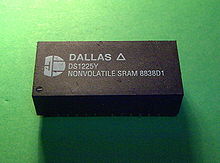NVRAM
NVRAM (abbr. For English Non-Volatile Random Access Memory ) is in the electronics , a non-volatile data storage , based on RAM and its data contents are retained without external power supply.
Conventional RAM such as dynamic RAM (DRAM) or static RAM (SRAM) lose their data content if the external power supply is lost.
species
A common method of forming an NVRAM is to combine a conventional volatile RAM memory with an energy store in the form of a battery , an accumulator or a double-layer capacitor with a particularly high electrical capacity . The energy store, also referred to as a buffer battery , provides energy for the data retention of the RAM memory over a certain period of time. Typically, SRAM cells are used as memory. Unlike DRAM memories (Engl. A continuous refresh refresh ) require the memory cells, SRAM need very little power for data preservation.
In the static - that is, in the non-active - state in which the memory content is kept, CMOS- SRAM components have only a very low power requirement in the range of a few nanoamps , which can be supplied by lithium batteries . Lithium batteries only have a low self-discharge and can guarantee data retention for periods of more than 10 years. In the case of compact designs, the battery and the SRAM memory can be combined in a chip housing as an NVRAM component.
In addition to the combination of backup batteries with conventional SRAM memories, there are NVRAM technologies that are based on various physical effects such as ferroelectricity . The memory content is written to memory cells that can maintain their bistable state even without an energy supply. Examples of this class of NVRAM are:
- Ferroelectric Random Access Memory (FeRAM)
- Magnetoresistive Random Access Memory (MRAM)
- Phase-change Random Access Memory (PCRAM)
- Nanotube-based Random Access Memory (NRAM)
Most of these new approaches try to store the information in the charge in a small capacitor , similar to DRAM cells . Furthermore, attempts are also being made with special semiconductor materials such as silicon carbide (SiC) to realize bistable NVRAM cells (this is still in the research stage), which should guarantee the memory content for over a million years at room temperature.
In addition to NVRAMs, non-volatile memories also include EEPROMs , flash memories or EPROMs that can be electrically programmed once or several times . NVRAMs are distinguished by the following functional differences:
- NVRAM can be written to without first being deleted.
- With NVRAM, writing a new value is as fast as reading. No programming sequences or additional waiting cycles have to be observed when writing.
- The number of write operations is not limited and NVRAMs are normally organized unsegmented in terms of their memory structure.
Applications
NVRAM is used wherever smaller, variable amounts of data such as configuration data, starting from a few tens of bytes up to a few mebibytes , are to be stored for a longer period without an external power supply. A typical application is NVRAM, known as CMOS-RAM in personal computers . The BIOS parameters and hardware configurations of a PC system are stored in this NV-SRAM .
Individual evidence
- ↑ Data sheet ( Memento of the original from January 1, 2010 in the Internet Archive ) Info: The archive link was automatically inserted and not yet checked. Please check the original and archive link according to the instructions and then remove this notice. an NV-SRAM. (DS2030 with 32 KB × 8 with integrated buffer battery; PDF) (Engl.)
- ↑ JA Cooper, MR Melloch, W. Xie, JW Palmour, CH Carter: Progress and Prospects for Nonvolatile Memory Development in Silicon Carbide . Institute of Physics Conference Series, No. 137/7, 1993, pp. 711 to 714 .
literature
- Paul Horowitz, Winfield Hill: The Art of Electronics . 2nd Edition. Cambridge University Press, 1998, ISBN 0-521-37095-7 .
